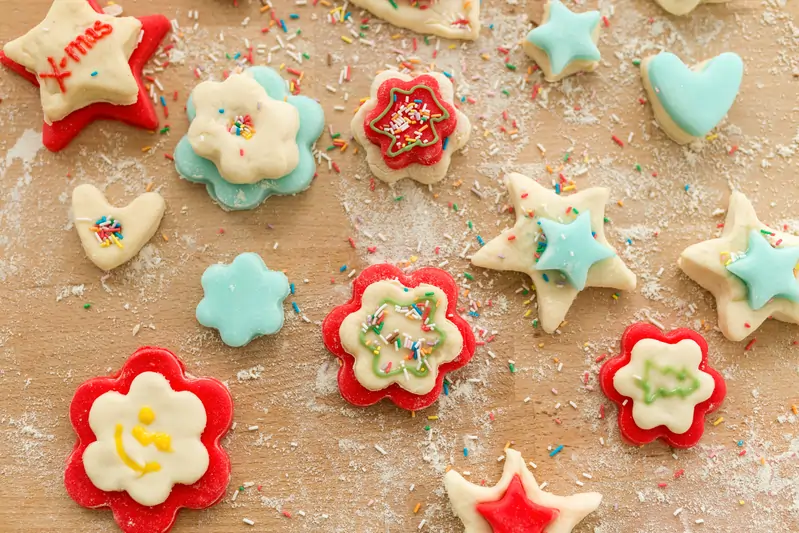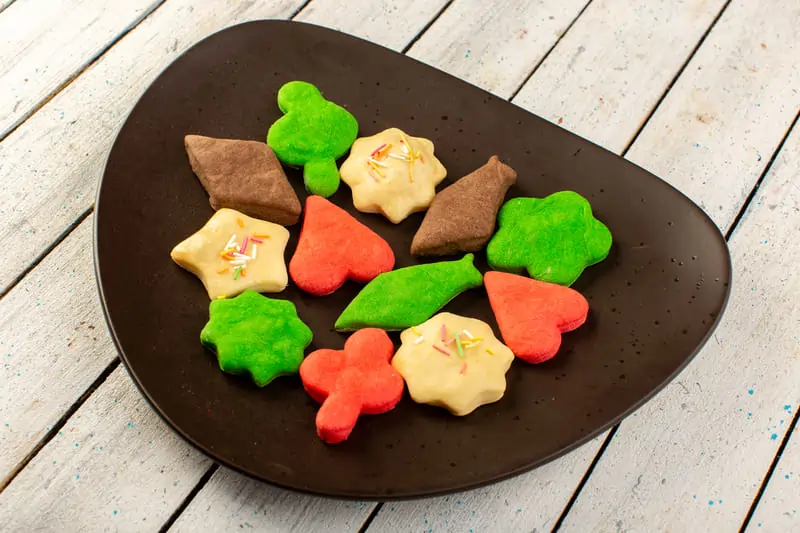Sugar cookies are a timeless favorite, but adding color takes them to the next level of creativity. The answer to whether you can use food coloring in sugar cookies is a resounding yes! Whether you’re looking to tint the dough, decorate with vibrant royal icing, or paint intricate designs, food coloring offers endless possibilities. Let’s explore how to use food coloring effectively to make your sugar cookies stand out.
For a creative twist on baking, explore how to make cookie color, which provides easy tips for vibrant designs. If you’re interested in other colorful cookie ideas, check out colorful ingredients in cookies for more inspiration.
Understanding Food Coloring for Sugar Cookies
When it comes to decorating sugar cookies, the type of food coloring you choose plays a crucial role in achieving both the look and consistency you desire. Each form of food coloring—liquid, gel, powder, and natural—has its specific uses and benefits. For further insights and vibrant icing recipes, you may find it helpful to check out our guide on sugar cookie decorating techniques.
Liquid Food Coloring
Overview: Liquid food coloring is the most accessible type, found in most grocery stores. It’s water-based, making it very easy to mix into icings and doughs.
Pros:
- Very user-friendly and great for small-scale baking projects or when subtlety in color is needed.
Cons:
- Because it’s water-based, adding too much can alter the consistency of your cookie dough or icing, potentially making them too wet.
Usage Tips: Best used when only a small amount of color is needed, as it integrates seamlessly without needing much adjustment to the recipe.
Gel Food Coloring
Overview: Gel food coloring is more concentrated than liquid forms and doesn’t dilute the consistency of the cookie dough or icing as much.
Pros:
- Provides vibrant color without requiring a lot of product.
- Minimal impact on the texture of the dough or icing due to its thick consistency.
Cons:
- Can be a bit more difficult to evenly distribute without thorough mixing.
Usage Tips: Ideal for coloring large batches of icing or dough where you need intense color without changing the mixture’s consistency. Always mix thoroughly to avoid color blotches.
Powdered Food Coloring
Overview: Powdered food coloring is used primarily in professional baking but is becoming more available for home use. It’s perfect for dry mixes and applications where liquid content must be controlled.
Pros:
- Provides intense color with a very small quantity.
- Does not alter the moisture balance of doughs or icings.
Cons:
- Requires careful handling to avoid clumping and uneven distribution.
Usage Tips: Best for intricate decorative work, like sugar art or dry applications, and when mixing directly with other dry ingredients before combining with wet components.
Natural Food Coloring

Overview: Natural food colorings are made from concentrated extracts of fruits, vegetables, and spices. They offer a chemical-free coloring option for those seeking more health-conscious alternatives.
Pros:
- Free from synthetic dyes and chemicals.
- Can add subtle flavors along with color, which might enhance the overall taste profile of your cookies.
Cons:
- Colors may not be as vivid or predictable as artificial options.
- Some natural colors can change when exposed to high heat during baking.
Usage Tips: Perfect for those who prefer all-natural ingredients. Effective in recipes where flavor and color enhancement from natural sources like beet juice, turmeric, or spirulina can complement the dish.
How to Color Sugar Cookie Dough
Coloring sugar cookie dough can transform ordinary cookies into vibrant, eye-catching treats. The key to success lies in choosing the right type of food coloring and incorporating it effectively into the dough. Here’s a detailed step-by-step guide to ensure even distribution and maintain the quality of your dough. For more baking tips and tricks, you may find it useful to explore our collection of easy cookie recipes.
Choosing the Right Coloring
Recommendation: Gel or powdered food colorings are ideal for dough as they provide intense color without adding extra liquid to the mix.
Why It Matters: Liquid food colors can alter the moisture balance of your dough, potentially affecting the baking results. Gel and powdered dyes give you vibrant colors with minimal impact on dough consistency.
Adding Color Gradually
- Start Small: Begin with a small amount of color—a drop or pinch—and gradually add more to achieve the desired hue.
- Mix Thoroughly: Ensure the color spreads evenly throughout the dough to avoid streaks. Use a sturdy spoon or your hands to fold the color into the dough.
Why This Step is Crucial: It prevents over-saturation and ensures that the entire batch of dough is uniformly colored. Avoid Overmixing the Dough
Technique: Mix the color into the dough until just incorporated. Overmixing can lead to tough cookies as it develops the gluten in the flour too much.
Result: Keeping the mixing to a minimum ensures that your cookies will have a tender, delicate texture after baking.
Dividing Dough for Multiple Colors

- Section the Dough: If you’re planning to make multicolored cookies, divide your dough into separate bowls before adding color.
- Color Each Section: Add different dyes to each portion of dough, following the gradual addition and thorough mixing guidelines.
Why Divide First: This method allows for greater control over the intensity of each color and ensures that each portion of dough can be customized.
Additional Tips
- Wear Gloves: To avoid staining your hands, consider wearing gloves when mixing colored dough.
- Use Separate Utensils: To prevent cross-contamination of colors, use separate mixing spoons or tools for each dough section.
Decorating Sugar Cookies with Food Coloring
After your cookies have been baked to perfection, the next step is decorating them with colorful icing and food colorings. This phase of the process allows for immense creativity and personalization of your treats. Below, I’ll delve deeper into popular methods such as using royal icing, painting with edible colors, and creating marbled icing designs. Each technique offers a unique way to beautify your cookies, making them as impressive to look at as they are delicious to eat. For more decorating techniques and creative ideas, you might enjoy exploring our guide to cookie decoration.
Using Royal Icing
Method:
- Prepare Royal Icing: Start with a basic royal icing mixture of powdered sugar, meringue powder, and water.
- Add Color: Incorporate gel food coloring into your royal icing to achieve both bold and pastel shades. Gel colors are recommended because they provide vibrant color without thinning the icing.
- Application: Fill a piping bag with your colored icing and use various tips to apply precise designs to your cookies.
Benefits: Royal icing dries hard and smooth, making it perfect for detailed and layered designs. The fine control from piping bags allows for intricate patterns and text.
Painting with Edible Colors
Method:
- Prepare Edible Paint: Mix a small amount of gel food coloring with a few drops of alcohol (like vodka) or lemon juice to thin it out. This mixture should resemble the consistency of paint.
- Painting: Use fine brushes to apply the colored mixture to the cookies. This technique is ideal for adding detailed accents or artistic flair.
Tips:
- Alcohol or lemon juice evaporates quickly, preventing the icing from becoming too wet and preserving the texture of the cookie.
- This method is great for adding fine details or blending colors directly on the cookie surface.
Creating Marbled Icing Designs
Method:
- Prepare Multiple Colors: Mix up several colors of royal icing.
- Marbling Technique: Drizzle or drop different colors of icing close together on the cookie’s surface. Then, use a toothpick or a small skewer to swirl the colors together gently, creating a marbled effect.
- Finishing Touch: Allow the icing to settle and dry, forming a smooth, marbled pattern.
Visual Appeal: Marbled icing creates a stunning visual effect that looks sophisticated and unique. Each cookie will have its own distinct pattern, adding to the charm of this decorating method.
Creative Uses of Food Coloring
Food coloring is a versatile tool that can transform your sugar cookies from simple treats into eye-catching, creative masterpieces. By experimenting with techniques like marbled dough, ombre designs, and festive themes, you can make your cookies stand out at any event. These ideas not only enhance the aesthetic appeal but also add a fun, artistic dimension to your baking. For more inspiration, you can explore our collection of unique holiday-themed recipes.
1. Marbled Dough
Technique:
- Prepare Dough: Divide your sugar cookie dough into two or more sections and dye each one a different color using gel food coloring for vibrant hues.
- Combine Colors: Place small pieces of each colored dough next to each other and lightly press them together.
- Swirl Effect: Gently knead the dough just enough to swirl the colors without fully blending them.
- Cut and Bake: Roll out the marbled dough and use cookie cutters to create shapes. The swirling effect will make each cookie uniquely patterned.
Why It’s Great: Marbled dough is a simple way to add elegance and individuality to your cookies. It works wonderfully for themes like tie-dye or galaxy designs.
2. Ombre Designs
Technique:
- Color the Dough: Start with a base color and divide the dough into several sections. Gradually add more food coloring to each section to create varying shades of the same color.
- Layer and Blend: Arrange the sections of dough from lightest to darkest and lightly blend the edges where they meet for a smooth gradient.
- Shape and Bake: Roll out the layered dough, cut into shapes, and bake as usual.
Why It’s Great: Ombre designs offer a sophisticated, gradient look that works perfectly for themed events like weddings, baby showers, or birthdays.
3. Festive Themes
Technique:
- Choose Holiday Colors: Match your food coloring choices to the occasion. For example:
- Christmas: Red, green, and white.
- Halloween: Orange, black, and purple.
- Easter: Pastel pinks, yellows, and blues.
- Add Details: Use cookie cutters shaped like holiday symbols (e.g., trees, pumpkins, or eggs) and decorate with complementary icing colors or sprinkles.
- Layer Creativity: Incorporate marbling, ombre, or other designs to give your cookies a festive flair.
Why It’s Great: Festive-themed cookies bring a touch of celebration to any occasion, making them a perfect gift or centerpiece for gatherings.
Is Food Coloring Safe for Sugar Cookies?
Yes, food coloring is generally safe for use in sugar cookies, provided you use FDA-approved food colorings or those that comply with food safety standards in your region. These colorings are rigorously tested to ensure they are non-toxic and suitable for consumption. However, if you have concerns about artificial additives or are catering to dietary preferences, there are plenty of natural alternatives to achieve vibrant colors without synthetic dyes. For more guidance, you can explore our guide to natural food coloring alternatives.
FDA-Approved Artificial Food Colorings
Artificial food colorings are widely used in baking due to their ability to produce bold, consistent shades. They are particularly effective for intricate designs or themed cookies that require vivid, reliable colors.
Safety Considerations:
- Ensure the food coloring is labeled as food-grade and approved by regulatory agencies such as the FDA.
- Use in moderation, as excessive amounts may affect the taste of the cookies or leave a residue.
Usage Tips:
- Gel and powder dyes are preferred for their high pigment concentration and minimal impact on dough consistency.
Natural Food Coloring Alternatives
For those seeking chemical-free or additive-free options, natural food coloring offers a healthier and eco-friendly alternative. These are derived from fruits, vegetables, and other natural sources, making them a great choice for clean-label baking.
Popular Natural Colorants:
- Beet Juice:
- Color: Produces rich red and pink tones.
- Uses: Perfect for Valentine’s Day cookies or romantic-themed designs.
- Pro Tip: Use beet powder for a more concentrated color that doesn’t affect dough moisture.
- Turmeric:
- Color: Yields a vibrant yellow.
- Uses: Ideal for spring-themed cookies or designs featuring sunshine and flowers.
- Pro Tip: Add a small amount to avoid an overpowering flavor.
- Spirulina:
- Color: Provides a natural earthy green.
- Uses: Great for Christmas trees, shamrocks, or nature-inspired designs.
- Pro Tip: Mix with other natural greens like spinach powder to adjust the shade.
- Blueberry or Purple Sweet Potato:
- Color: Delivers soft purple or blue hues.
- Uses: Excellent for Easter cookies or whimsical galaxy designs.
Transitioning to Natural Options: Switching to natural food colorings is a simple way to accommodate health-conscious consumers or meet specific dietary needs. While the colors may be softer and less predictable than artificial dyes, they add unique flavors and a touch of authenticity to your baked goods.
Tips for Perfectly Colored Sugar Cookies
Creating beautifully colored sugar cookies requires a mix of technique and creativity. Whether you’re working with natural or artificial food coloring, following these best practices can help you achieve vibrant, evenly colored cookies every time. For additional insights on coloring and decorating, be sure to check out our complete guide to sugar cookie decorating.
1. Use Gloves
Why It’s Important: Food coloring—especially gels and powders—can easily stain your hands during the mixing process. Stains not only make cleanup more difficult but can also transfer to other surfaces or decorations.
Pro Tip:
- Opt for disposable food-safe gloves to keep your hands clean and prevent accidental color transfer.
- If you don’t have gloves, rubbing a bit of lemon juice or baking soda on your hands after mixing can help remove stains.
Transition: While gloves protect your hands, the next tip ensures your colors turn out just right.
2. Start Small
Why It’s Important: Adding too much food coloring at once can lead to oversaturated hues that may overpower your design or alter the dough’s consistency.
How to Do It:
- Begin with a small drop of gel or a pinch of powdered food coloring.
- Gradually add more until the desired shade is reached, mixing thoroughly between additions.
Pro Tip: Keep in mind that colors may intensify during baking or after the dough rests, so it’s better to start with a lighter shade and build up gradually.
Transition: Once you’ve achieved the right color, you can enhance the visual appeal and flavor synergy by pairing colors with complementary flavors.
3. Enhance Vibrancy with Flavor Pairings
Why It’s Important: Matching colors with flavors adds a sensory dimension to your cookies, making them more memorable and delicious.
Examples of Pairings:
- Yellow: Use lemon zest or extract to complement bright yellow colors. Perfect for spring or summer-themed cookies.
- Green: Add peppermint or matcha for a refreshing flavor that pairs beautifully with earthy green hues.
- Red or Pink: Pair with strawberry, raspberry, or rose for a sweet and floral note.
- Blue or Purple: Blueberry or lavender extracts work wonderfully with soft pastel shades.
Pro Tip: Subtle flavor pairings can also help mask any taste from natural food colorings, such as turmeric or spinach.
Transition: While these tips focus on preparation, how you handle the dough during decorating also plays a crucial role.
4. Mix Thoroughly
Why It’s Important: Unevenly mixed dough can result in blotchy or inconsistent colors. Ensuring a uniform blend creates cookies with a polished, professional appearance.
How to Do It:
- Use a stand mixer for large batches to evenly distribute color throughout the dough.
- For smaller batches, knead the color into the dough by hand, folding it over repeatedly until consistent.
5. Let Dough Rest
Why It’s Important: Allowing your colored dough to rest can help the color deepen and stabilize, leading to more even results.
How to Do It:
- After mixing in the color, wrap the dough in plastic wrap and refrigerate it for 15–30 minutes. This also helps with handling and prevents the dough from becoming too sticky.
Troubleshooting Common Issues
Even with the best techniques, challenges can arise. Here’s how to resolve them:
- Fading Colors: Use gel or powder dyes, and avoid high baking temperatures.
- Uneven Coloring: Mix food coloring thoroughly before baking.
- Color Bleeding: Chill cookies before applying multi-colored designs.
FAQs
Can You Use Food Coloring in Sugar Cookies?
Yes! Food coloring works beautifully in both the dough and the icing. Learn more about how to add vibrant colors to your cookies in this guide on how to make cookie color.
What Is the Best Type of Food Coloring for Sugar Cookies?
Gel or powdered food coloring is recommended because it provides vibrant, even colors while also ensuring that the consistency of the dough remains unaffected. If you’re looking for inspiration, explore sugar cookie decorating techniques for creative ideas.
Can I Use Natural Food Coloring?
Absolutely! Natural options like beet juice and turmeric not only add beautiful colors but also allow you to create cookies using healthier, chemical-free ingredients. Moreover, for those seeking more information, explore natural food coloring alternatives for a comprehensive guide.
How Do I Prevent Colors from Fading in the Oven?
To keep colors vibrant, make sure to choose heat-stable dyes like gel or powder and bake at a lower temperature. Additionally, for troubleshooting common baking issues, visit tips for vibrant baking to ensure your cookies turn out beautifully every time.
Can I Mix Different Types of Food Coloring?
Yes, you can! Combining different types of food coloring not only allows for unique shades but also creates fun and creative effects on your cookies. For instance, if you’re looking for inspiration, check out unique holiday-themed cookies to discover exciting ways to elevate your baking.
Conclusion
Using food coloring in sugar cookies is a fun and effective way to personalize your treats. Whether you opt for natural dyes or artificial colors, the results can be stunning and delicious. Experiment with marbled designs, festive themes, and bold patterns to create cookies that impress.
For further ideas, check out easy cookie coloring techniques. Transform simple sugar cookies into vibrant edible masterpieces!

